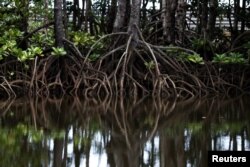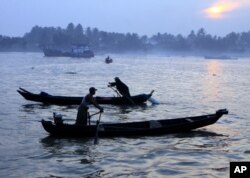Water and climate experts from across Asia are stressing the need to work with nature, rather than against it, to save the continent's "disappearing deltas," home to some 400 million people.
Mounting research blames a confluence of rising sea levels driven by global warming and the damming and dredging of key rivers and their tributaries for the rapid sinking and shrinking of Asia's seven major delta systems, from the Indus in Pakistan to the Pearl in China.
The experts say swelling cities are adding to the pressure by weighing down the deltas and sucking up groundwater. The seven deltas alone host 14 of the world's 33 megacities, including Bangkok, where the experts are gathered this week, parts of which are sinking by 2 centimeters a year.
Losing the deltas will not only erase some of the world's most diverse ecosystems, experts add, but drive mass migration, deplete vital farmland and disrupt some of Asia's most dynamic business hubs.
The Pearl River Delta, which empties into the South China Sea past Hong Kong, has been dubbed the "world's workshop" for its abundance of busy factories. In Vietnam, forecasters say 1 million people will have to leave the Mekong River Delta, the country's rice bowl, by 2050.
"These are some of the most vulnerable places to climate change and change across river systems, but they are also the home for a number of us who live here, they are also the breadbasket of the world that feeds a number of the countries that depend on them," said Kavita Prakash-Mani, global conservation director for the World Wide Fund for Nature (WWF).
"So while we are worried about numerous ecosystems around the world, we really need to be putting special attention on our delta systems and the wetlands and all the other ecosystems they support," she added.
The WWF is hosting a three-day forum in Bangkok, which started Wednesday, to help researchers and policymakers from across Asia tackle the problem, learn from each other and brainstorm new and better ways to save the deltas.
The environmental protection group and others are pushing the idea of "building with nature," where nature is used to cope with climate change — think mangrove seeding to cushion coastal communities from floods — and development falls in step with the natural world's rhythms.
"So it's not just about building high walls and keeping the water out. It is really about restoration — restoring wetlands, mangroves, rivers and enabling them to flow, enabling them to create the kind of deltas that we want, [and] the resilience that comes from that and the protection it will then afford us from rising sea levels. It is one of our best solutions," said Prakash-Mani.
Anamitra Anurag Danda, a senior visiting fellow on climate change at India's Observer Research Foundation, said protecting deltas means not only adapting to rising sea levels but taking care of the rivers that feed them.
He said the rivers and tributaries of India's Ganges Delta, part of the largest delta system in the world, "have been either dammed or barraged, and therefore the sediment that would otherwise have built the delta does not reach the delta."
Between that and a thirsty city of Kolkata drawing hundreds of millions of liters of water daily out of the ground, the delta lost 16,300 hectares of land in the 40 years leading up to 2009, said Anurag Danda, who also advises the WWF.
He said more sinking and shrinking of the deltas was "inevitable," and it would mean retreating from some areas to give them time to recover.
But that won't be practical everywhere.
"It's not just building with nature," said Stuart Orr, a WWF freshwater expert. "Of course we need traditional infrastructure as well. But we need to be thinking a lot more intelligently about how we modify our river systems and our delta systems, and allow that new science to creep into our decision-making and investments."
Tiziana Bonapace, with the U.N. Economic Commission for Asia and the Pacific, said better climate modeling, early warning systems and other hi-tech solutions could prove "game changers" in helping the many millions who call the deltas home stay put and stay safe.
She said her office was now working across 15 Asian countries to improve flood forecasting for the Ganges-Brahmaputra-Meghna Delta System, drawing attention to the need for countries to work together.
Seri Suptharathit, of the Center on Climate Change and Disaster at Thailand's Rangsit University, said the governments of those countries also had to work harder at thinking about the problem and its solutions in terms of generations, rather than election cycles.
"Politics thinks only to four years, but this is 30 years, 80 years. How [do] we ask them to think for the future, for the young generation?" he said.
Should they fail, Seri quipped wryly, guests arriving at any forum on Asia's sinking and shrinking deltas in Bangkok three or four decades hence may have to make the trip by boat.









